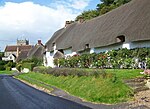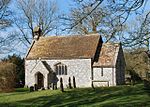Berwick St James
Civil parishes in WiltshireEngvarB from August 2019Villages in Wiltshire

Berwick St James is a village and civil parish on the River Till in Wiltshire, England, about 7 miles (11 km) northwest of Salisbury, on the southern edge of Salisbury Plain. The parish includes the hamlet of Asserton. At the 2001 census the parish had a population of 185, reducing to 142 at the 2011 census.The village High Street is the B3083 road which follows the river: south to Stapleford and the A36 Warminster-Salisbury road, and north to Winterbourne Stoke and the A303 trunk road, which cuts across the north-west of the parish.
Excerpt from the Wikipedia article Berwick St James (License: CC BY-SA 3.0, Authors, Images).Berwick St James
High Street,
Geographical coordinates (GPS) Address Phone number Nearby Places Show on map
Geographical coordinates (GPS)
| Latitude | Longitude |
|---|---|
| N 51.153 ° | E -1.899 ° |
Address
High Street
SP3 4TN , Berwick St. James
England, United Kingdom
Open on Google Maps








